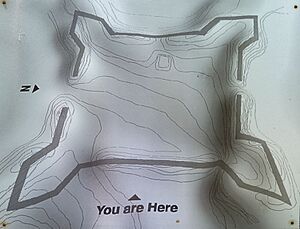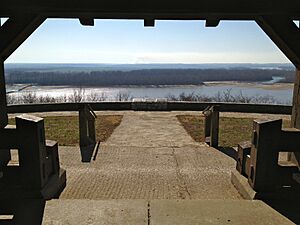Fort Kaskaskia State Historic Site facts for kids
Quick facts for kids |
|
|
Fort Kaskaskia SHS
|
|
|
U.S. Historic district
Contributing property |
|

Eroded ramparts of Fort Kaskaska
|
|
| Location | County Roads 3 and 6, west of Chester, Illinois |
|---|---|
| Built | 1754 |
| Part of | French Colonial Historic District (ID74000772) |
| Added to NRHP | April 3, 1974 |
Fort Kaskaskia State Historic Site is a large park near Chester, Illinois. It sits on a bluff overlooking the Mississippi River. This site remembers the old frontier town of Old Kaskaskia. It also honors the help the town gave to George Rogers Clark during the American Revolution.
Contents
The Story of Kaskaskia Village
The village of Kaskaskia, Illinois started in 1703. It was founded by Jesuit missionaries at the mouth of the Kaskaskia River. Soon, settlers from Quebec and Louisiana began to arrive. They were drawn to the rich farmland of the central Mississippi Valley. These settlers built a village and farms near the Jesuit mission. The area was a half-circle of land surrounded by the Kaskaskia River and a bend in the Mississippi.
French-speaking pioneers were known for treating Native Americans fairly. However, as Kaskaskia grew, local Native Americans, part of the Illini Confederacy, may have felt there wasn't enough space. Around 1759, the French settlers built Fort Kaskaskia. This "fort" was actually an earthen redoubt, which is a small, enclosed fort. Frontier settlers often built these earthworks for defense against threats.
In 1763, France gave the Illinois country, including Kaskaskia and its redoubt, to Great Britain. The British did not use the redoubt, leaving Kaskaskia almost unprotected. Kaskaskia remained a French-speaking village on the Mississippi River frontier.
Kaskaskia in the American Revolution
In early 1778, George Rogers Clark wanted to protect western Virginia and Kentucky. These areas were facing attacks from Native Americans allied with the British. Clark led a small group down the Ohio River. He hoped to surprise the British by joining forces with the French-speaking settlements in the Mississippi Valley.
Clark and his men marched overland from Fort Massac to Kaskaskia. They avoided being seen by the British or their Native allies. They arrived at Kaskaskia on July 4, 1778. Most of the townspeople welcomed them.
Later, Clark and his men faced a threat from a British force at Vincennes, Indiana. Kaskaskia became their starting point to capture Vincennes in early 1779. The Americans controlled Kaskaskia and its redoubt for the rest of the war. They gained legal control of the territory in the 1783 Treaty of Paris.
Kaskaskia: An Important American Town
After the war, Kaskaskia became part of the United States. Its large French-speaking population slowly became more American. In 1803, Lewis and Clark stopped here. They recruited many skilled hunters and sharpshooters for their journey to the Pacific Ocean. This famous expedition took place from 1804 to 1806.
The village served as the only capital of Illinois Territory from 1809 to 1818. It was also briefly the first capital of the new U.S. state of Illinois. Illinois joined the Union on December 3, 1818. Pierre Menard, a rich fur trader, lived across the Kaskaskia River. He was elected the new state's first Lieutenant Governor.
The Great Flood and a New Home
During the 1800s, especially after the American Civil War, the Mississippi River changed its course. It cut through many of its old bends, making its channel shorter.
In 1881, a big flood occurred. The powerful Mississippi River "discovered" a much smaller, parallel riverbed. This was the mouth of the Kaskaskia River. The Kaskaskia's bed was a few feet lower than the Mississippi's. So, the entire Mississippi River shifted into this new path. It cut across the head of a former river bend to do so.
For the village of Kaskaskia, the river's new path was a disaster. Their village had been by the waterfront of the smaller Kaskaskia River. Now, the mighty Mississippi River was swallowing the town. Even the village cemeteries were in danger.
In an emergency, about 3,000 graves from Kaskaskia were moved. The remains were reburied on top of the bluff to the east. This was the site of old Fort Kaskaskia. The state of Illinois agreed to protect this site forever. It serves as a memorial to the historic village that vanished.
Fort Kaskaskia Today
Today, Fort Kaskaskia is a campsite and picnic area. It still overlooks the Mississippi River. You can still vaguely see the remains of the 18th-century redoubt in the earth. The large Kaskaskia cemetery reminds visitors of the 1881 flood.
In 1974, the site became one of the important places in the new French Colonial Historic District. Other French-influenced sites in the area include Fort de Chartres, the Creole House, the Kolmer Site (an old Native American village), and the Pierre Menard House.





